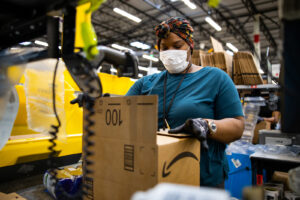With day-to-day business challenged to the very highest degree, sourcing and procuring in the supply chain is more complicated than ever before. But while some have struggled, others are at the forefront of the frontline response to the pandemic. Michelle Mooney investigates.
The global lockdown has put incredible strain on supply chains and a great scrutiny on sourcing and procurement methods. This has resulted in a huge shift to organisations delivering tasks and sourcing and purchasing remotely.
Yet, for those lacking the structures to support this, their inability to purchase goods and services has temporarily affected many aspects of their operations as they joined the ranks of businesses seeking relevant supplies urgently – and often manually.
 Paul Massey, Product Director at Proactis, explains: “The sudden need to increase sourcing and purchase of specific categories of items also put pressure on a number of sectors. PPE was the main – but not the only – category. For example, not all organisations were experienced in having staff working from home, so there was pressure to source IT equipment to support employees in doing this.
Paul Massey, Product Director at Proactis, explains: “The sudden need to increase sourcing and purchase of specific categories of items also put pressure on a number of sectors. PPE was the main – but not the only – category. For example, not all organisations were experienced in having staff working from home, so there was pressure to source IT equipment to support employees in doing this.
“Supply chains were also affected by pivoting organisations who suddenly required new products and services while reducing their demand from their traditional channels. While food retailers faced bigger demand, most of the hospitality sector had to put orders on hold, as did whole swathes of the economy while lockdown was at its most severe.
“As lockdown restrictions flex, businesses such as restaurants face unique challenges in needing to hold orders due to forced closure, and then switch orders back on when restrictions allow reopening.”
For Jonathan O’Brien, Chief Executive at Positive Purchasing, future procurement excellence will be less about savings and tactical buying but more about how it can connect the best supply base capability and talent, working as a network at locations around the world.
“The future of procurement and logistics is one of dramatic change, with a shift to a new strategic focus and automaton of routine, demanding a next generation of specialists many of which may not come from the traditional procurement routes.
“Traditional ‘buying’ will no longer need a team but only management of the new technological systems that will do this for us, however, the new game in town is where procurement and logistic experts become architects of how supply base possibilities can enable a new wave of competitive advantage by leading strategic projects to connect with, build relationships and trade as the customer of choice to suppliers that will operate in very different ways to how they do today,” says O’Brien.
“Covid hasn’t changed anything here, it has just accelerated the imperative for the companies of the future to get on and drive these changes.”
Survival Mode
 Sarah Riding, partner at law firm Gowling WLG, says that the last 12 months have seen an unprecedented amount of pressure on supply routes forcing adaptability within supply chain strategy.
Sarah Riding, partner at law firm Gowling WLG, says that the last 12 months have seen an unprecedented amount of pressure on supply routes forcing adaptability within supply chain strategy.
“However, much of the planning approaches that are now being prioritised are – while more aligned to technology than ever before – fundamentally loyal to the core methodology of modern supply chain practice: the consistent review and re-alignment of supplier relationships that not only deliver more efficiently but are leading to much more transparent relationships across the supply chain tiers,” she says.
While the current scenario for many will have been ‘survival mode’, it is important to look at how risking forward-thinking, new approaches can help deliver the results and confidence needed to get back to active growth.
“Of course, this requires a realistic approach to the supply chain model – for example, the obvious intensifying of online retail has challenged the sector in an unprecedented manner and has shone a light on why some hold back from expanding their digital footprint,” says Riding. “The burgeoning budget supermarket sub-sector relies on the costs saved through not offering an online service in order to offer such favourable prices. While this may be seen as limiting to its future sector footprint, the practical considerations are key.
“The major warehouse space required to facilitate online supermarket provision is limited in the UK, which highlights the need to take account of all aspects of a supply chain related decision to achieve the desired outcome.”
So, while it may not be possible to forecast accurately, it may be possible to predict more accurately, mitigating some of the potential problems which could arise in the case of a future pandemic, says Simon Geale, Senior Vice-President for Client Solutions at Proxima.
“What is clear is that procurement teams are no longer looking solely at their primary supplier and if they are hitting their SLA’s or KPI’s, they are much more cognisant about the wider supply chain and external factors that can impact upon them.
“There is a challenge for many global businesses that their supply chains are simply too long, complex and intertwined to be pandemic proof. This is a direct consequence of highly specialised and leveraged just-in-time supply chains, and the speed to which they all came down. It’s clear that it’s no longer good enough to know your own suppliers, you have to know your supply chains and the risks that lurk within.”
Geale says a lot of the retrospective actions are focused on getting technology in place to accurately visualise the state of a business and its supply chain. This, he says, is clearly a good thing, but it should be noted that many of the success stories were down to the actions of individuals either working with data, or working on instinct. In a market where logistics and supply chain operations are constantly benefitting from digital tools, he says, the importance of talent should not be underestimated.
Immediate Impact
Philip Ashton, Co-Founder and Chief Executive of 7bridges, says that the immediate result of lockdown and Covid-19 was that sourcing and procurement became more complicated and, therefore, slower. But, he says, effective procurement strategies require high levels of contact between the supplier and supply chain and operations teams, which became much harder under lockdown.
“At the same time, the sourcing and procurement process became more urgent. We’ve seen multi-supplier and multi-site strategies become increasingly important, with greater robustness and greater flexibility in the supply chain prioritised.
 “Sourcing and procurement teams have always been a target for cost-cutting, particularly if they sit one step removed from the operational side of the supply chain. However, for effective procurement, greater integration is needed. There is a need to deploy technology to help make procurement decisions faster and smooth the handover between sourcing and operations, making implementation more efficient.
“Sourcing and procurement teams have always been a target for cost-cutting, particularly if they sit one step removed from the operational side of the supply chain. However, for effective procurement, greater integration is needed. There is a need to deploy technology to help make procurement decisions faster and smooth the handover between sourcing and operations, making implementation more efficient.
“Forecasting is difficult at the best of times – in times of great uncertainty, it is nigh-on futile. Instead businesses should focus on identifying fragility in the supply chain and targeting that for elimination. Rather than forecasting probabilities, businesses should focus on building systematic adaptability; working through ‘worst case’ scenarios and ensuring they have the suppliers, partners and technology in place to adapt effectively, whatever happens.”
Digitising processes is vital for procurement teams setting out a strategy to help them adapt and succeed in the new normal, says Alex Saric, Smart Procurement Expert at Ivalua.
“Digitising procurement allows data to be brought together from the business, suppliers and third parties, generating informed decisions, ensuring failsafe measures are put in place and finding replacement suppliers quickly in the event of a sudden failure. This will give organisations a 360-degree view into their supply chains and enable remote collaboration with suppliers, so they can assess their overall vulnerabilities and conduct contingency planning.”
This feature originally appeared in the October issue of Logistics Manager.







